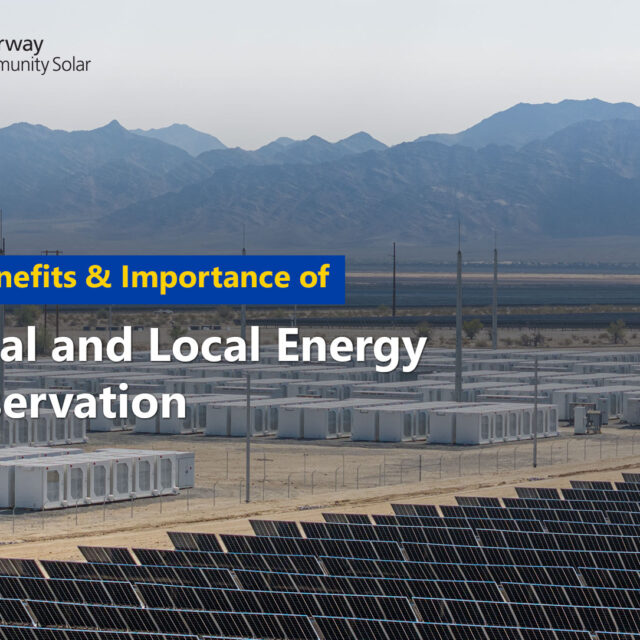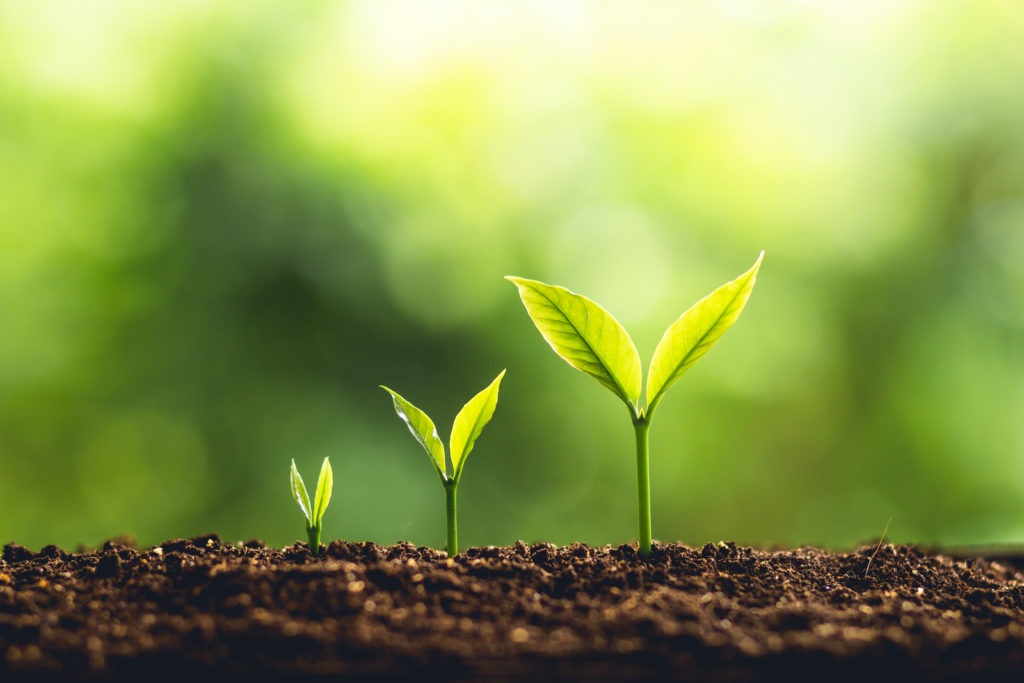
Parental Note: This experiment can be completed independently by children 8 years of age and older. The project may require some support to track plant growth and take anecdotal notes over the span of two weeks.
Additional Note: This experiment will take roughly two weeks to complete; this calculation takes into consideration both the set up time and time needed for plant growth.
Experiment Overview:
The sun is a renewable energy source that plays a pivotal role in our everyday life, from warming the earth to the water cycle, it is an essential part of our daily existence. Did you know that the sun also plays a critical role in the growth of plants? Without the sun, plants wouldn’t get the necessary food needed to grow, reproduce, and survive.
Plants need three basic things to live: sunlight, water, and carbon dioxide. Through a process called photosynthesis, the plants use the energy from the sun to convert carbon dioxide, soil nutrients, and water into food! In this experiment, we are going to 1) observe the germination of seeds and track the growth as ‘Basil’ (a herb used for seasoning) plants emerge 2) track the growth of basil seeds exposed to three different light sources (full sun, some sun, limited/no sun) and observe photosynthesis in action! Before we begin, let’s think about these three important questions:
Can a seed grow/germinate/develop into a plant with limited or no sunlight?
How do you think a seed will grow with some or partial sunlight? What do you think the plant will look like after two weeks of growth?
What will be the difference between the three sunlight exposure plants? How do you think the plants will be alike?
Experiment Materials:
- 1 packet of basil seeds (other seed types can be used: grass, chives, bean)
- 3 small plastic cups
- Potting soil
- 1 small shovel
- Watering can
- Notebook & pencil
- 3 different growing locations: full sun, partial/some sun, no/little sun
Experiment Process:
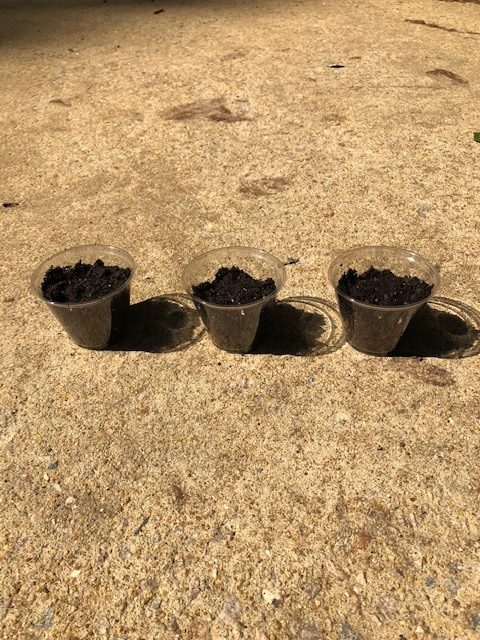
Step 1
Take three small plastic cups and fill them rough ¾ of the way with potting soil.
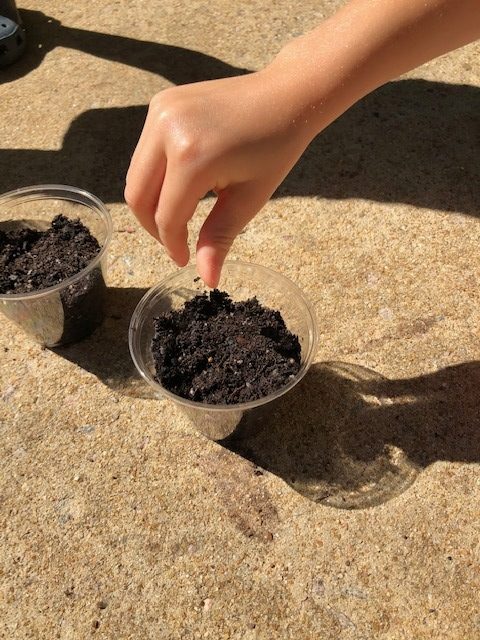
Step 2
Collect a small handful of basil seeds (roughly 30 seeds) and sprinkle them evenly around the top of each soil cup. Each cup should get roughly the same amount of basil seeds so that the growing conditions are consistent.
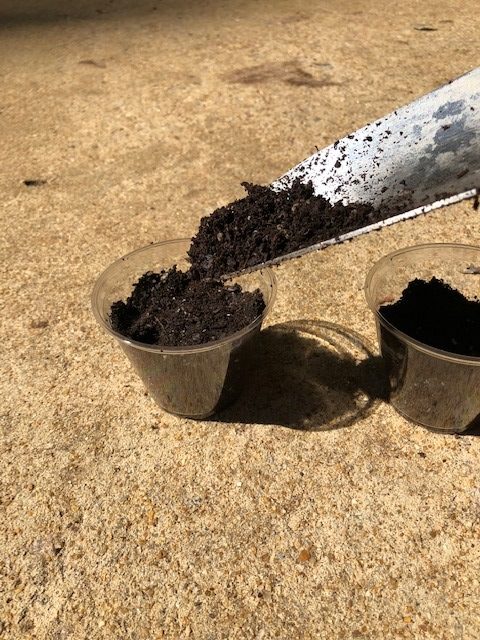
Step 3
Place a thin layer of soil over the seeds. The soil placed on the top of the seeds should be no thicker than ⅛ of an inch so the spouts can quickly and easily push through the soil.

Step 4
Water each plant until the soil is moist and start the germination process.
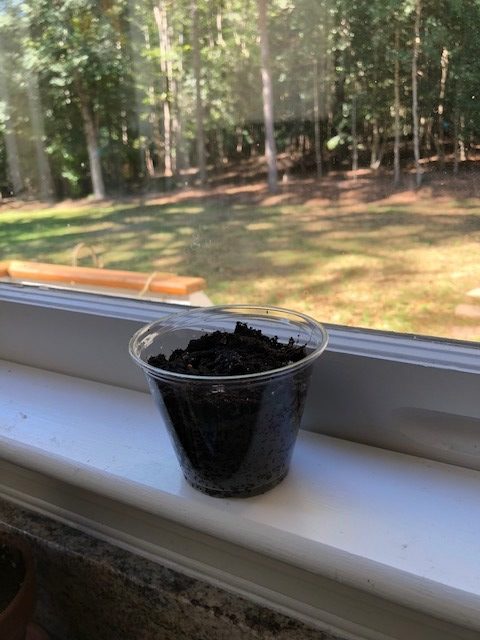
Step 5
- Place each cup in a different growing environment.
- Place one of the plant cups in full/direct sunlight. (Example: a window seal that gets full sun all day)
- Place another in a location that gets some sun but not direct/full sun. (Example: a bookshelf that gets some sun indirectly from the kitchen window)
- Place the last cup in a location that gets little to no sun. (Example: a shut drawer in the kitchen so that the plant receives no/little sun throughout the growing process)
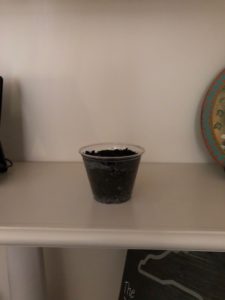
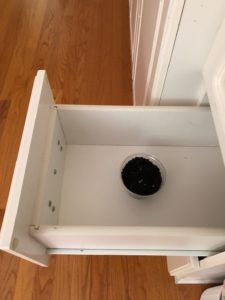

Step 6
Organize a notebook for anecdotal notes. Refer to the picture below.
Note: the science notebook should allow for a small number of notes to be taken each day during the growing process. Notes such as: how much water was provided, sprouts that have begun to grow, leaf formation, the height of plants, etc. Provide space for each plant and for 14 days of notes.
Step 7
Over the span of two weeks, track the growth of the seeds and provide water when necessary. Make sure to take notes on the growth of the basil and observations that seem important.

Results - Day 6
The growth experiment lasted 14 days. Below are the anecdotal notes and pictures that were taken throughout the plant growth.
After 6 days of growth:
- Germination has occurred and small shoots pushed through the surface of the soil.
- The “full sun” and “some sun” shoots are more abundant and were roughly ¼ of an inch in size.
- The “little to no sun” exposure produced only two shoots that were ⅓ of an inch in size
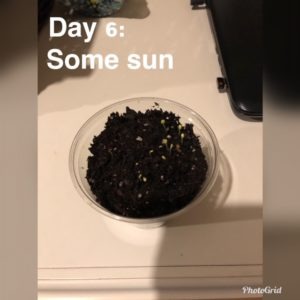
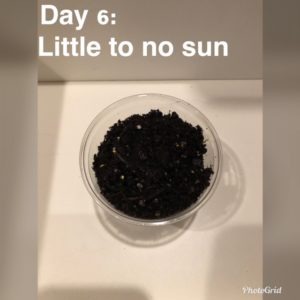

Results - Day 10
After 10 days of growth:
- The “full sun” cup produced 33 sprouts that were ¾ of an inch in size
- The “some sun” cup had 14 spouts that were 1 inch in size
- The “limited sun” cup had 11 basil sprouts that were 1 inch in size. The leaves were yellow in color and the stems were a transparent white.
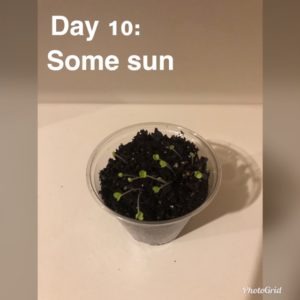
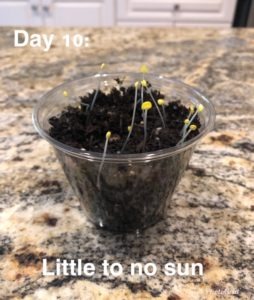
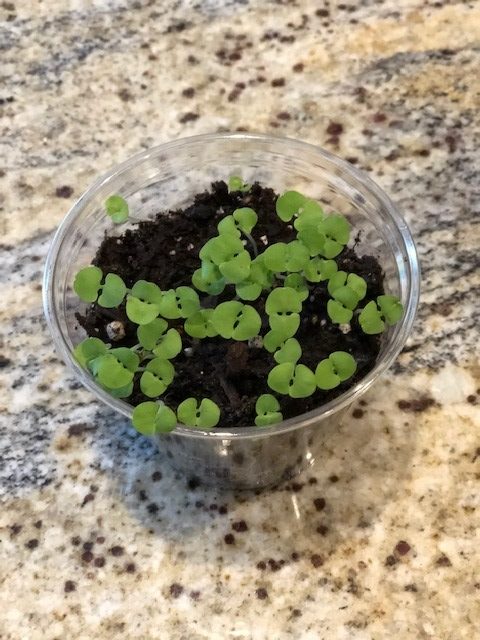
Results - Day 14
After 14 days of growth:
- The “full sun” sprouts began to bloom and develop larger (basil) leaves.
- The “some sun” sprouts started to grow more towards the sunlight. Seven of the sprouts started to grow larger (basil) leaves.
- The “limited/no sun” sprouts grew taller (1 ¼ inches) but the leaves did not develop and the yellow color worsened (as did the white stems).
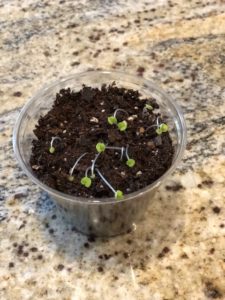
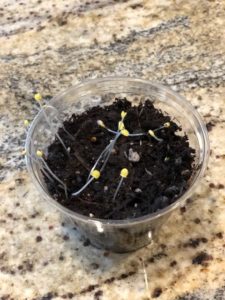
Conclusions:
Now that we have witnessed the growth of a seed to plant and can better understand the role of sunlight in the growing process, it is important to discuss a few ideas:
- Germination occurred in all three growing environments. The process started when the seeds were provided with soil and constant water supply. The water started metabolic (growth) activities within the seeds that produced enough energy for plant growth. When the shoots emerged, photosynthesis began. (It is interesting to think that germination can occur in almost complete darkness.)
- Plants are called autotrophs; meaning that they create their own food source. To make food, plants need carbon dioxide, water, and sunlight; this process is called photosynthesis.
- Photosynthesis is the process by which green plants make their own food. Photosynthesis happens when a plant absorbs carbon dioxide, nutrients, and water through the holes found in the roots (branches, stem, flowers, leaves, etc.) of the plant. The light energy (from the sun) then triggers a chemical reaction that breaks down the carbon dioxide and water molecules. This process creates a sugar called glucose and also produces oxygen. The glucose is then broken down by organelles called chloroplast and provide the energy needed to grow and repair plants. Each chloroplast contains a green chemical called chlorophyll which gives the leaves a green color. Both the “full sun” and “some sun” plants were able to allow for photosynthesis due to sunlight exposure.
Additional note: Photosynthesis provides food for the plant and also releases oxygen into the atmosphere for humans to breathe. - If a plant gets limited sunlight, the photosynthesis process slows down and the plant begins to grow upward and stretch their stems to reach for the sunlight (this process is called etiolation). It is easy to see this process in both the plants that received partial and limited/no sun. These basil plants grew to have longer stems and reached out towards the sunlight energy.
- Plants deprived of light will lose their color and die. The shoots exposed to “limited/no” sunlight had a yellow/white color due to the fact that photosynthesis could not occur. The lack of sunlight stunted photosynthesis and therefore the sprouts were not able to produce the chlorophyll needed to create a green color.
Overall, this experiment depicts just how important the sun is to the survival of plants and also humans (oxygen supply). Without proper sunlight, plant growth would stop due to the lack of photosynthesis and all of the other components needed for healthy plant growth. Once again, it is easy to see just how important the sun, a renewable resource, is to both plants and mankind.
Extension:
Variations to experiment
Parents, feel free to try the following variations to the experiment:
- Vary the seed used in the experiment. Will the seeds germinate at different rates?
- Try altering the experiment by placing the plants in an outside location during nicer weather. (Make sure to place one plant in full sun, one in partial sun, and the other in a location with no or limited sun).
Extension/Study Questions:
- How do plants grow? What is needed for proper plant growth?
- What is photosynthesis?
- What is a chloroplast and why is it important to plant growth?
- What are the key ingredients to produce a healthy plant?
- Can plants be grown through the use of artificial lighting? If so, research this idea to better understand growing plants indoors and through artificial light sources.
- What is the effect of sunlight on plant growth?

